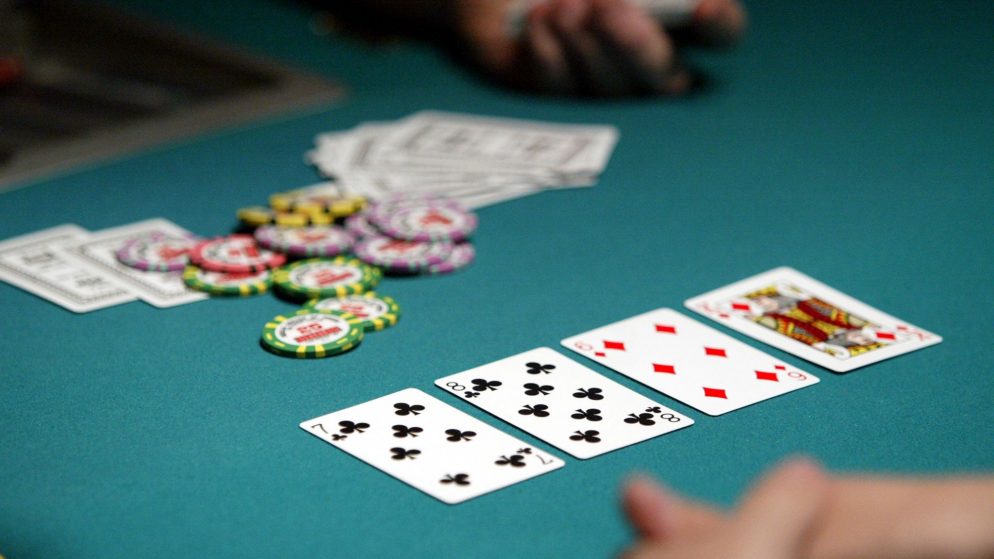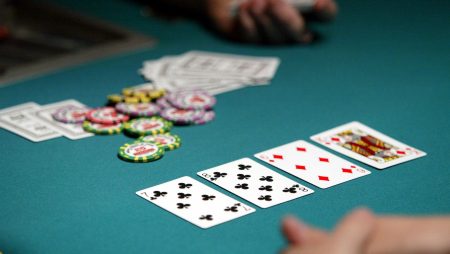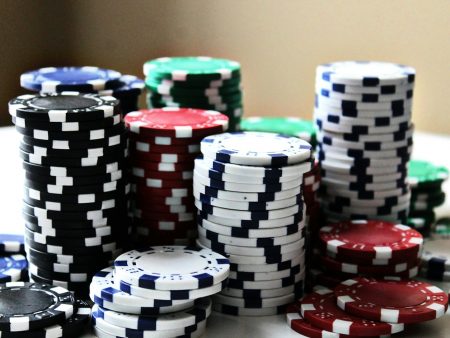

Poker is included among the most popular games around the globe. The unique thing about this game is that it is easy to learn. However, excelling might take years. Poker involves card, and it’s a pure game of strategy. It requires continuous readings of the opponent’s strategy for deciding when to fold, bluff, or call to another player’s bluff. Poker has a lot of variations, and the rules might vary based on the type you play. However, we will take one of the most famous poker types for our understanding, i.e., Texas Hold’em. Each variation has its own set of rules that differ from others, but the basics always stay the same. You can even develop your winning strategy if you master the basics.
Playing a round of Texas Hold’em

Learning the 10 Best 5-card Hands and Knowing What Each Rank
The hands do not change based on the type of poker you play. Therefore, it is important to familiarize yourself with various kinds of hands. The first thing you should do is print out the cheat sheet and start studying it because memorizing various hands might help you recognize them easily. The following list contains the major winning poker hands. These are ranked in descending order.
- Royal Flush – The Royal Flush is the top-ranked hand. It is also referred to as the royal straight flush. It contains Ace, Jack, 10, King, and Queen belonging from the same suit and one kind, i.e., all should be wither spades, hearts, clubs, or diamonds. Moreover, this hand cannot be beaten by another suit’s royal flush; it can only be tied. A royal flush is rare. It might occur only once in a blue moon.
- Straight Flush – A Straight Flush occurs when the player gets 5 consecutive cards belonging to the same suit.
- 4 of a Kind – As the name suggests, 4 of a Kind occurs when the player has four cards of the same rank and different suits, while the fifth card can be of any rank.
- Full House – For a Full House to occur, the player has three matching cards belonging from the same rank, while the remaining two cards should form another rank forming a pair.
- Flush – In Flush, the player should have five cards of the same suit. It does not require any sequence. The aim is to be from the same suit, while the rank does not matter.
- Straight – A straight happens when the player has five cards from different suits with consecutive rank.
- 3 of a Kind – For 3 of a kind, the player should have two unmatched cards and three cards of the same rank.
- 2 Pair – 2 pair occurs when a player has two cards from the same rank, two from another rank that differs from the other pair, and an unmatched card.
- Pair – The pair is simple. This hand happens when the player has three unmatched cards with two cards of the same rank.
- High Card – The hard card is the least ranked hand. On the other hand, the cards do not belong to the same suit. They are not in consecutive order. However, for high cards, two cards should have the same rank.
TIP: When two players face off through the same kind of hand, then the player with higher-ranking cards gets the victory. Moreover, if both hands’ ranks are the same, both the players will be the winner, and the prize will be evenly distributed.

Place the Starting Bets, i.e., Blinds or Ante Up
There are two ways of placing bets in poker. While playing the Texas Hold’em, the small blind is placed by the player sitting very next to their dealer. The small bet is often half of the minimum bet that players usually place. While the player sitting to this player’s left places another bet that’s either equal or more than the minimum bet. Moreover, players also have another option that’s called ante up. In an ante up, both players can place the minimum starting bet. Additionally, ante up is used in the majority of the poker variants.

Looking at the Two Cards in Hand Given by the Dealer
The deal has the responsibility to burn. This means that the dealer is responsible for taking out the first card from the game. Afterward, the two cards are passed out to all the players. When you get your card, it is vital to check them to know what you hold.
- The dealer burns the cad after every dealing round. This rule has been imposed to make it less predictable for the players to anticipate the card. It makes the game like a gamble.
- The cards are passed in a clockwise direction that starts from the left.
TIP: It is important to keep the secret of your card in poker. Don’t show your hands to other players even if they are out before the showdown occurs. Otherwise, they might willingly or unintentionally reveal your cad value.

Dealing Raise, Bet, or Call after Each Round as Per Your Choice
Players should make a bet every time dealer puts out a new card. The first bet is made based on the first two cards in their hands. In poker, betting occurs like a circle. The following points might help you during your turn to bet.
- If no other player has placed the bet yet, then you should place it.
- For avoiding betting, say check.
- For matching your bet with other players, say call.
- For raising more money, say raise. When a player says raise, the other players chose to fold or call your bet.
- If you disagree with another player’s bet, then you should say fold. After saying fold, it is essential to face-down your cards. This avoids the chances of giving an advantage to other players.

Knowing If a Player has Good Hand by Looking at the Flop
When the first round of betting finishes, the dealer burns the first card on the deck. Afterward, three cards are placed on the table. These face-up cards are called the flop. Players can use these cards to build their hands. Moreover, players can also compare these cards with theirs and then decide to fold, call, or bet.
- The dealers reveal five cards throughout the game. Players will have seven cards to make their best five, i.e., five community cards and two cards in hand. After the flop, it is important to take some time and analyze the table to know your position and form your strategy.
- In some places, players can also draw other cards called replacements. This happens typically after the betting round.

Checking Turn Card after Second Betting Round
After burning the top card, the dealer will place another card face up near the flop. This card is called the fourth street card or the turn card. Before deciding to bet, fold, or phone, you should first check and analyze all the cards in your hand and the table.
- Normally, you can also request an exchange here. However, this is not allowed in professional games.
- While looking at the cards, you should also analyze other players’ cards. For example, if the table has four hearts, it indicates that one of the players has the last heart that can flush the game.
- Moreover, if you see 8,7,6, and 5 on the table, then the player with 9 or 4 can have a straight.
- You can choose to fold if the cards in your hand are not helpful, while the cards on the table provide good winning potentials.

Deciding on the Hand to Play through the River Card
After the top card’s burning, the dealer puts one last card faced upwards near the turn card. This card is then called the river card. Afterward, players can check the community cards and the cards in hand for deciding their five best cards. Then you can fold, call, or bet.
- Sometimes, the rules allow the players to exchange hands during this round. However, in professional games, this practice is forbidden.

Clockwise Revealing of Player’s Hands During Shutdown
After the last round is completed by players’ choices to call, fold, or bet, all the remaining participants must participate in the final shutdown. The shutdown starts from the most left players to the dealer, and all the players will eventually reveal their cards. The player with the highest hand wins the entire pot.
- The players split the pot in case of any tie.
- You will not be allowed to show your cards if you have folded your hands.
- The remaining cards are not counted in the Texas Hold’em other than the seven cards.
- Players can play on the board, i.e., playing the cards on the table only. However, this strategy should be normally avoided.
Adding Betting and Strategy

Estimating Risk on Starting Hand
It is important to look at the cards for checking for consecutive numbers, pairs, face cards, and the cads from the same house. Decide either to place a bet or not based on your cards.
- If you have a pair, aces, or face cards, then you should always raise. Moreover, placing a bet is also recommended when the player gets a king, an ace, or a queen and an ace. If the player has these cards, then he should place the bet before the flop. This will raise the pot’s value.
- Players are suggested to either fold or bluff if the required card does not come. If you have good bluffing skills, then despite bad hands, you will still win the game.
Bidding Starts from the First Player to the Left to Dealer or Big Blind
When the first round begins, the dealer begins the bidding from the person to the left of the big blind. However, in later rounds, the bidding begins from the dealer’s left. Afterward, the bidding occurs in a clockwise direction.
- In games where the ante strategy applies instead of blind, the bidding should always begin from the dealer’s left.
Strategy to Call the Bet for Staying in the Game despite Undesired Cards
This strategy should be applied when the players do not have desired cards but still wants to stay in the game without raising a bet. In this instance, the player should call and match the bet before choosing to add chips or raising money to the port. This finishes your turn.
- Check and fold if a flop occurs and you do not have a right hand. It is better not to bet on the hand that you know won’t win.
- Bet if the flop occurs and you have a great hand. This will raise the pot’s value by forcing players with weaker hands on the table.
Raise the Bet with Good Hand
It’s always wise to raise the bet if a player has a good hand. Placing a bet will end your turn.
- You can say, “I want to increase the bet to $40”.
- Players can’t rise above the maximum bet.
Variation
Players can also use a bet trick for misguiding other players and make them think you have good cards. It’s a bluffing technique.
Fold in High Bets and Bad Hands
If you are not satisfied with your hands or the bet on the table is too high, then you should fold to save yourself.
- Even if you fold, avoid showing your cards to your opponents.
- Knowing when to fold is a key strategy, and it is not an easy task to realize.
Deciding to Draw any Cards
This strategy might vary based on the rules the game has. If your hand does not support your play, you can request replacement cards and discard the cards you want to change.
- Discarding cards normally do not have any limit.
- In Texas Hold’em, players are not allowed to request replacement cards. So, read the game rules before you start playing.
Play with the Money You can loose
If you are a beginner, you always start smaller and avoid gambling more than your acceptable limit. Unless you develop the game’s required expertise, you should not place higher bets; otherwise, you might go broke.
- Players normally set the target of 200 bets. So, if you are betting $5, then your bank should have $1000.
- Start tracking your losses and winning if you are a constant player to avoid major losses.
- To avoid legal trouble, pay taxes on your wins.
Read Basic Tells
Poker is more about playing opponents than playing actual cards. If you want to play this game well, you should be aware of both your and your opponents’ tell. Analyze the betting patterns and estimate their coming moves.
- Blinking, shallow breathings, flushing red, eyes watering, etc. are some of the classics used by players.
- Shaking hands indicates nervousness, while putting a hand over mouth shows the excitement and a way to hide a smile.
- Staring at the chips shows a strong hand.
- Players likely bluff when they stare each other down in an attempt to impress.
Conservative Players and Aggressive Players
Player’s betting patterns can be identified from the type of player they are. If the players fold early, they might be conservative players.
- Conservative players are easy to identify because they are not willing to lose much money.
- Aggressive players bet higher and take more risk.

Looking Like a Pro
Developing Quick Instincts by Practicing and Watching Other Players
If you want to better in your play, then you should begin practicing and watching more. Poker games might vary based on where you play; that’s why it is essential to develop your instincts rather than memorizing tricks. Observe players, match their patterns, and learn their strategies.
- Improve your strategy by analyzing other players. Compare what would have been your strategy in such instances.

Shuffle the Cards and Cut the Deck before they are Dealt
Shuffling the cards ensures a fair game. You can do a basic shuffle by splitting the deck into two and flipping the cards into each other, and combining them.
- Shuffle more than once.
- If you like, cut the deck more.
- Button position occurs typically when the dealer shuffles the cards till the end of the bet.
Say Check or Tap the Table Twice Using Two Fingers
By saying check, players choose not to place a bet in the current moment. At the beginning of a new hand, players can say check at their turns.
- In the rounds ahead, saying check means players want to stay at the existing bets paid into.
- Players can’t say check or maintain their check if another player raises the bet. In such instances, they have the option to fold or bet.
Say I Open
If another player has not placed the bet, you can say I open and start placing your bet. The turn begins moving clockwise if the players do not say I open.
- The discarded cards are shuffled and added to the draw stack’s bottom by the dealer.
Say I Call
If players want to bet on the same amount as the opponents, they should say I call.
Increasing Betting Amount through Raise
If the players want to increase the amount of bet, they can say I raise the bait (to whatever amount they desire).
Say I Fold
If a player is ready to quit a hand, then he should say I fold. It helps the player to forfeit his cards and give up the pot with all the bets. Afterward, the players can wait for the next deal.
- A player can fold at any point during the game.
Cash-In
A cash-in is used by the players when they want to quit the game and use the chips to convert them into cash. Layers can take the chips to the bank and request cash-in. However, players can still stay and watch the game even after a cash-in.
Variations in Poker

Mastering Fiver-Card Draw’s Basics
Before the game begins, the rules should be agreed on in this variation. An example of this basic is to decide which cards are low and high.
- Deciding the betting structure
- Decide who deals first
Learning 3-Card Draw
Players make an ante bet to begin the game while the players can decide whether to fold or bet. Afterward, the dealer reveals the cards for a showdown, and the player with the best hand wins.
- The rules might vary based on where the game is played.
Studying Obscure Variations
Learning rules of other variations help players understand the games and impress people with their knowledge of poker. Some variations might be Omaha, Lowball, Dr. Pepper, and more.
Bonus:








